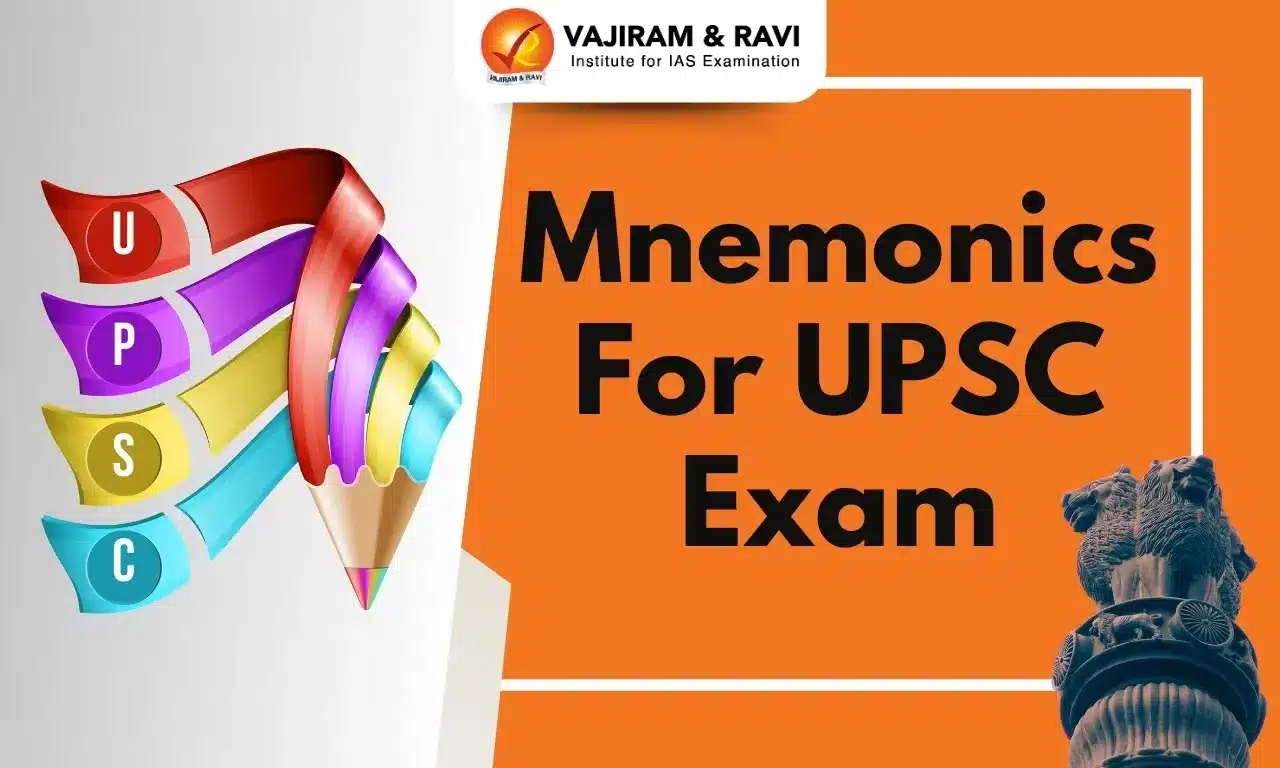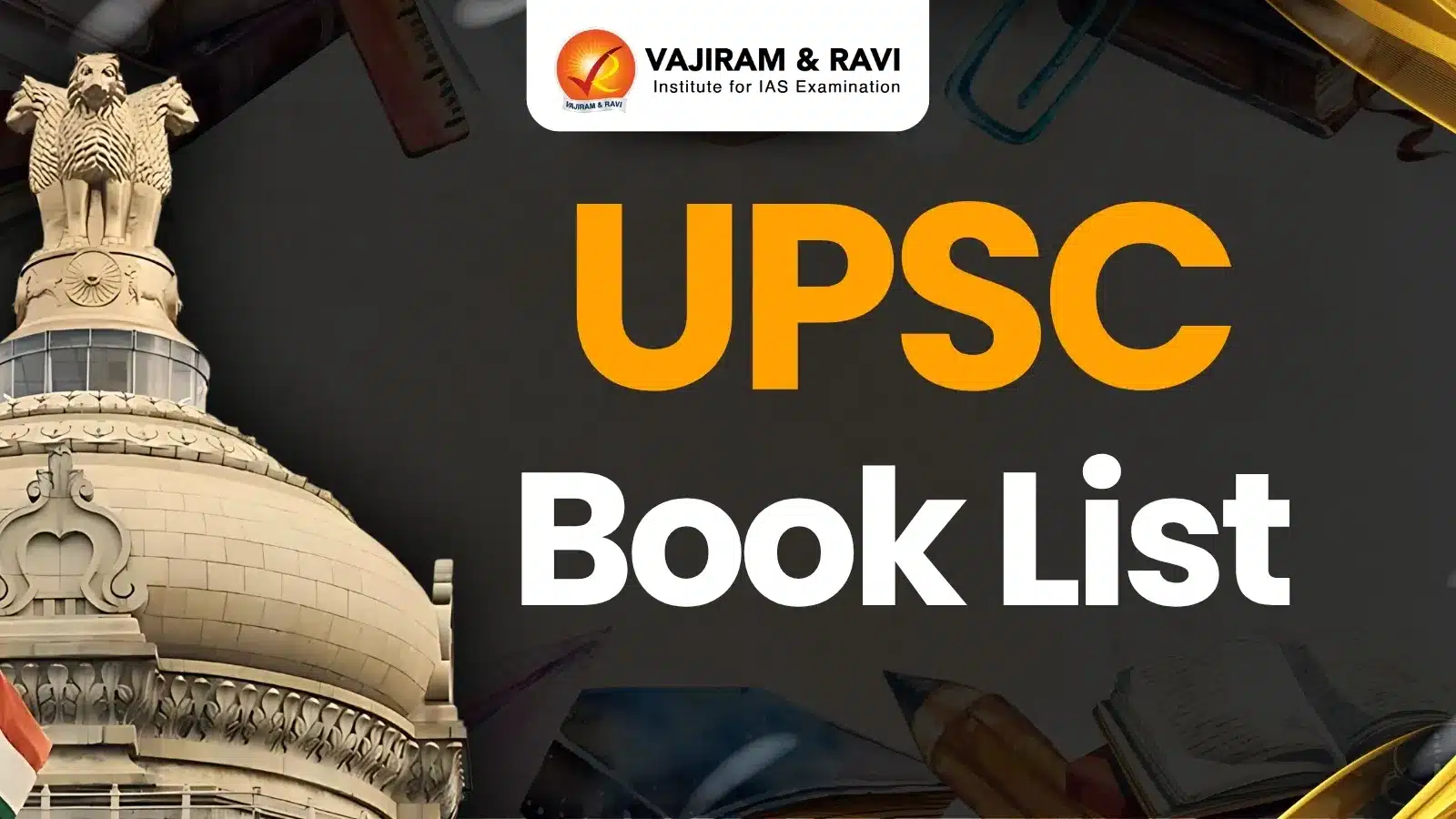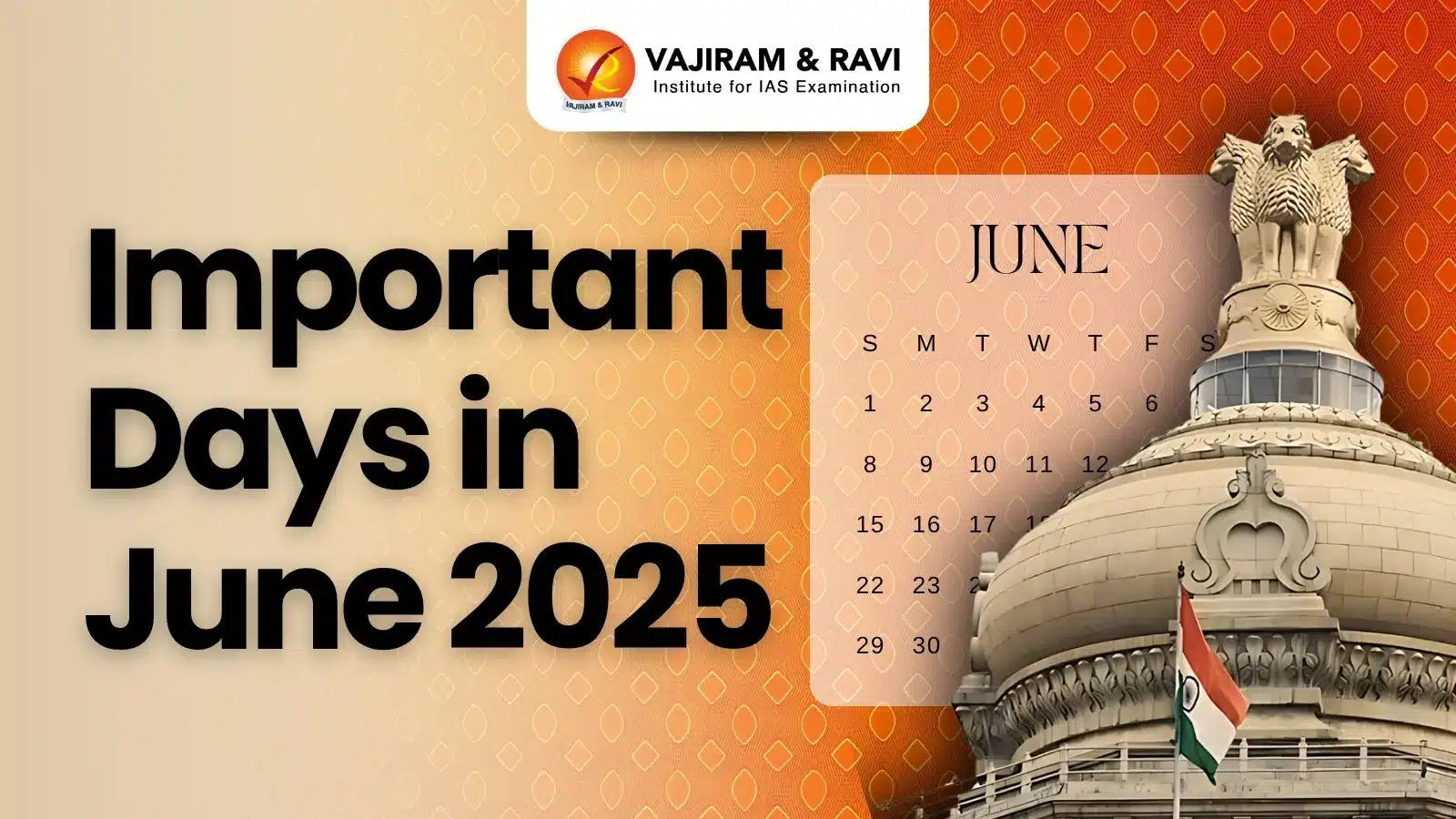Mnemonics for the UPSC Exam can be extremely useful for all the students preparing for UPSC CSE 2025. Known to be helpful as memory aids, mnemonics help in simplifying all the complex topics that could help in recalling during the exam. Mnemonics are a great strategy to remember the syllabus especially when it comes to UPSC Prelims 2025. These methods are designed to make learning more effective and better retention. In this article, we are going to cover a list of mnemonics that are relevant for UPSC 2025.
Mnemonics for UPSC CSE 2025
Mnemonics for UPSC Exam 2025 are powerful memory tools that make retaining complex information quicker and easier, helping you excel in this challenging exam. They are particularly useful for the UPSC Prelims, where memorizing facts, figures, and concepts is essential.
By converting difficult topics into simple acronyms, phrases, or sentences, mnemonics make learning more effective and fun. For example, remembering the layers of the atmosphere or the chronology of historical events becomes effortless with a catchy mnemonic.
Beyond improving recall, mnemonics also save valuable revision time, especially in the crucial final days before the exam. To support your preparation, we have compiled a subject-wise list of mnemonics to make learning smarter and stress-free!
UPSC Mnemonics for Geography
UPSC Geography Syllabus includes topics like human geography, physical geography and world geography and mnemonics can help in remembering the important terms and concepts especially maps and places. Examples include:
- Countries Bordering the Baltic Sea: RuDe Germany SELL Poland & Finland Ru – Russia De – Denmark Germany S – Sweden E – Estonia L – Latvia L – Lithuania Finland Poland
- Horn of Africa Countries: SEED
- S – Somalia
- E – Ethiopia
- E – Eritrea
- D – Djibouti
- Countries Bordering Caspian Sea: TARIK
- T – Turkmenistan A – Azerbaijan R – Russia I – IranK – Kazakhstan
- Equator Passes in Asia Through: Kiribati, Indonesia, Maldives (KIM)
UPSC Mnemonics for History
History is considered to be one of the most complex subjects especially when it comes to remembering the dates, events and figures making it challenging for some to remember. Mnemonics for UPSC Exam can help in retaining this information. Examples include:
Kings Who Practiced Buddhism:
- BAPU Ka Hath B – Bimbisara A – Ashoka P – Prasanjeet U – Udaysen Ka – Kanishka Hath – Harshavardhana
- Triratna in Jainism: KFC K – Right K nowledge F – Right F aith C – Right C onduct
- Delhi Sultanate: Sab Khao Tamatar Sab Lo Maze ( S lave, K hilji, T ughlaq, Sayyid, Lo dhi, M ughals)
- Mughal Emperors: BHAJSAB B – Babur H – Humayun A – Akbar J – Jahangir S – Shah Jahan A – Aurangzeb B – Bahadur Shah Zafar
- Key Modern History Events : Partition of Bengal, Dandi March, Non-Cooperation Movement, Quit India Movement , Home Rule Movement ( Parth’s Dad Never Quit History )
UPSC Mnemonics for Polity
Polity as a subject includes learning about the Indian constitution, all the articles, government functions, differentiation between the central and state government and various constitutional organisations. Examples of Polity mnemonics are:
Parts of the Constitution:
- U Can Fly Directly From United States Using Para Military Special Rocket.
- U = Union and its territories (1)
- C = Citizenship (2)
- F = Fundamental Rights (3)
- D= DPSPs (4)
- F = Fundamental Duties (4A)
- U = Union (5)
- S = States (6)
- U = Union Territories (8)
- P = Panchayats (9)
- M = Municipalities (9A)
- S = Scheduled and Tribal areas (10)
- R = Relation between Union and States (11)
- Schedules of the Indian Constitution: TEARS OF OLD PM
- T = Territory (I)
- E= Emoluments (II)
- A = Affirmations and Oaths (III)
- R = Rajya Sabha (IV)
- S = Scheduled areas (V)
- O = Other Scheduled areas (VI)
- F = Federal provisions, Union, State, Concurrent Lists (VII)
- O = Official languages (VIII)
- L = Land reforms (IX)
- D = Defection (X)
- P = Panchayats (XI)
- M = Municipalities (XII)
- Permanent members of UNSC: France, Russia, America, China, England ( FRACE )
- States with Bicameral Legislature: Karnataka, Andhra, Maharashtra, Bihar, UP, J&K, Telangana ( KAMBUJ – Tea)
- Methods to acquire citizenship – BRAND B – Birth R – Registration A – Acquisition of Territory N – Naturalisation D – Descent
UPSC Mnemonics for International Relations
UPSC Mnemonics for International Relations are essential tools for aspirants aiming to remember complex groups of countries and organizations. UPSC IR mnemonics make it easier to recall bordering countries such as:
- G20 Group: Germany, USA, Russia, United Kingdom, Japan, India, Saudi Arabia, Indonesia, Turkey, Australia, Argentina, Brazil, South Africa, South Korea, Canada, France, China, Italy, Mexico, European Union ( GURU JI SITA AB SSC FCI ME work karti hai).
- G4 Group: Brazil, India, Germany, Japan ( BIG Japan )
- ASEAN Countries: Malaysia, Burma, Brunei, Singapore, Cambodia, Laos, Indonesia, Philippines, Thailand, Vietnam ( MBBS CLIP TV )
- BIMSTEC Countries: Myanmar, Bangladesh, Bhutan, Sri Lanka, Nepal, India, Thailand ( MBBS NIT )
- India’s Bordering Countries from Largest to Smallest: Bangladesh, China, Pakistan, Nepal, Myanmar, Bhutan, Afghanistan ( BaChPaN MBA )
UPSC Mnemonics for Economy
The economy section covers topics like inflation, banking, fiscal policies, and more. Mnemonics for UPSC Exam for the economy subject can help in remembering complex terms and their meanings. Some useful UPSC mnemonics are: 8 Core Industries of India:
Coal, Crude, Cement, Fertilizers, Refinery, Electricity, Natural gas, Steel ( CCC FRENS )
Remember Indirect Taxes: ExCuSe ME
- E – Excise Duty
- C – Customs Duty
- S – Service Tax
- M – Motor Vehicle Tax
- E – Entertainment Tax
- Focus of Eleventh Five-year Plan:
- TEACHERS T – Tele-communication (2G) E – Electricity, Environment Science A – Anemia C – Clean water H – Health Education E – Environment R – Rapid growth S – Skill Development
- Tools for Monetary Policy:
- RC is RuDe R: Reserve Requirements (Cash Reserve Ratio) D: Discount Rate (Interest rate at which commercial banks borrow from the central bank) R : Repurchase Agreements (Repo Rate) C : Open Market Operations (Buying and selling of the government securities)
- LPG Reform L – Liberalisation P – Privatisation G – Globalisation
UPSC Mnemonics for Environment
The environment section includes topics like ecology, biodiversity, and environmental laws. Mnemonics for UPSC in the environment subject ensure that key facts are at your fingertips during the exam: Biodiversity Hotspots in India: We Have Incredible Sanctuaries
- Western Ghats
- Himalayas
- Indo-Burma
- Sundaland
Greenhouse Gases: CHAMP
- C – Carbon Dioxide (CO₂)
- H – Hydrofluorocarbons (HFCs)
- A – Ammonia (NH₃)
- M – Methane (CH₄)
- P – Perfluorocarbons (PFCs)
Environmental Acts in India: WATER
- W – Water (Prevention and Control of Pollution) Act, 1974
- A – Air (Prevention and Control of Pollution) Act, 1981
- T – The Environment (Protection) Act, 1986
- E – The Wildlife Protection Act, 1972
- R – The Forest Conservation Act, 1980
Major Forest Types in India: TIDAL
T – Tropical Evergreen
I – Temperate
D – Deciduous
A – Alpine
L – Littoral
How to Create Your Own Mnemonics for UPSC Preparation
Designing your own mnemonics can help in learning difficult topics from the UPSC syllabus. Personalized mnemonics align with your memory patterns, making it easier to recall during the exam. Here’s how you can create effective mnemonics:
- Break Down Complex Information – Identify tricky concepts and break them into smaller, easy-to-digest parts. Focus on the essential elements.
- Use Acronyms or Phrases – Form catchy acronyms using the first letters of key terms or create fun phrases that stick. For example, use “TEARS OF OLD PM” to remember the Schedules of the Indian Constitution.
- Make It Relatable – Connect mnemonics to personal experiences, familiar objects, or famous personalities. The stronger the connection, the easier the recall.
- Visual Mnemonics – Link information to images, patterns, or mind maps to enhance memory retention. Associating facts with visual cues strengthens recall.
- Practice & Review – Regularly revise your mnemonics to keep them fresh in your memory. Use them during quick revisions for better retention.
Last updated on May, 2025
→ UPSC Notification 2025 was released on 22nd January 2025.
→ UPSC Prelims Result 2025 will be out soon for the CSE held on 25 May 2025.
→ UPSC Prelims Question Paper 2025 and Unofficial Prelims Answer Key 2025 are available now.
→ UPSC Calendar 2026 is released on 15th May, 2025.
→ The UPSC Vacancy 2025 were released 1129, out of which 979 were for UPSC CSE and remaining 150 are for UPSC IFoS.
→ UPSC Mains 2025 will be conducted on 22nd August 2025.
→ UPSC Prelims 2026 will be conducted on 24th May, 2026 & UPSC Mains 2026 will be conducted on 21st August 2026.
→ The UPSC Selection Process is of 3 stages-Prelims, Mains and Interview.
→ UPSC Result 2024 is released with latest UPSC Marksheet 2024. Check Now!
→ UPSC Toppers List 2024 is released now. Shakti Dubey is UPSC AIR 1 2024 Topper.
→ Also check Best IAS Coaching in Delhi
Mnemonics for UPSC Exam FAQs
Q1. What is the 7/5/3 rule in UPSC?+
Q2. How to memorize for UPSC?+
Q3. What is the 80/20 rule in UPSC preparation?+
Q4. Is 27 too late for UPSC?+
Q5. Who cleared IAS at 32?+


















